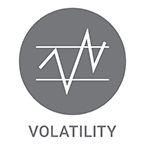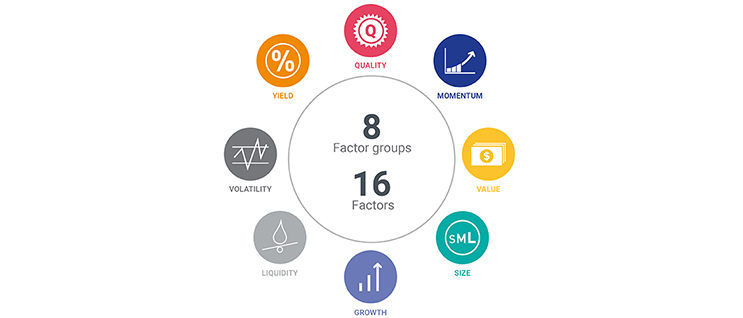Factor Investment Hero
Factor Investing
MSCI has developed factor indexes, FaCS and factor models backed by four decades of factor research and innovation
Sidebar Navigation
- About MSCI Factors
- Factor Indexes
- FaCS
- Factor models
Are factors too complicated?
About Factors By MSCI
About Factors by MSCI
In investing, a factor is any characteristic that can explain the risk and return performance of an asset. Beginning with Barra in 1976, MSCI has researched factors to determine their effects on long-term equity performance. Our factor indexes and models, developed in consultation with the world’s largest investors, are backed by research based on four decades of factor data compiled by a 200+ global research team.
MSCI has been a leader in factors for over 40 years. Explore the history of MSCI factors below.
Factor Timeline
The Capital Asset Pricing model attempted to measure how the risk of an investment may affect its expected return. The measurement of the sensitivity of a security to the broader market was called Beta
Developed by:
1961 Treynor
1964 Sharpe
1965 Litner
1966 Mossin
MSCI was a pioneer in developing the market for global equity indexes. We began licensing our first equity index products in 1969
Refining CAPM to create low volatility factor investing, demonstrated that stock portfolios with lower volatility tend to produce higher returns on average
Creation of the
multi-factor Barra risk models
Stephen Ross
Introduced the Arbitrage Pricing Theory (APT) - credited with original term "Factors" and
Low Volatility Theory
Rosenberg & Marathe
Academic Asset Pricing Literature and Practitioner risk factor modeling research
Suggested that Macroeconomic factors can systematically affect stock market returns
First generation Barra fixed income factor model launched
First generation MSCI Global Equity Model (GEM) launched
Expanded on the Rational Market Theory to demonstrate that company size and valuation factors are drivers of stock price
Published first research on Momentum factor
RiskMetrics methodology was launched by J.P. Morgan
Expanded on Fama-French three-factor model to include momentum factor, creating the Carhart four-factor model
MSCI acquired Barra, a provider of portfolio risk analytics tools that launched its first risk analytics products in 1975
MSCI acquired RiskMetrics Group, a leading provider of risk management and governance products and services.
Fourth generation Barra fixed income factor models launched
MSCI launches MSCI FaCS and Factor Box, an industry standard and factor classification for consistent implementation and measurement for Factor Investing
<!---->
Elements of performance video
Elements of performance: factors by MSCI
Factors are the building blocks of many portfolios. They are the elements capable of turning data points into actionable insights.
Factor Group
Factor groups
Factors have historically been identified as critical drivers of portfolio risk and return and can now be used to better inform the investment process. Factors may help investors meet their objectives such as reducing risk, increasing returns and enhancing diversification by providing a better understanding of risk and returns.
| Factor group | What it offers |
|---|---|
| Value Relatively inexpensive stocks |
Captures excess returns to stocks that have low prices relative to their fundamental value |
| Low size (small cap) Smaller companies |
Captures excess returns of smaller firms (by market capitalization) relative to their larger counterparts |
| Momentum Rising stocks |
Reflects excess returns to stocks with stronger past performance |
| Low volatility Lower risk stocks |
Captures excess returns to stocks with lower than average volatility, beta, and/or idiosyncratic risk |
| Dividend yield Cash flow paid out |
Captures excess returns to stocks that have higher-than-average dividend yields |
| Quality Sound balance sheet stocks |
Captures excess returns to stocks that are characterized by low debt, stable earnings growth, and other “quality” metrics |
| Growth Measure of change in sales and earnings |
Measures company growth prospects using historical earnings, sales and predicted earnings |
| Liquidity Size-adjusted trading volume |
Captures common variations in stock trading volumes relative to available shares trading |
Want more information on factors by MSCI? Have an MSCI representative reach out to you.
Factor investing parallax
Factor indexes
Factor indexes
MSCI factor indexes are designed to help institutional investors seeking to capture the excess return of factors in a cost-effective and transparent manner. Factor indexes can be used to implement factors through a passive portfolio. A factor index can also bring transparency to factor allocations, helping to alleviate the well-known problem of manager style drift and may have positive implications for risk management.
Due to the historical cyclicality of factors, investors may choose to diversify away from a single factor but not want to dilute their exposure to their targeted factors or change the risk profile of their portfolios. MSCI’s Multiple-Factor Indexes provide building blocks that allow investors to assemble multiple-factor allocations based on their objectives for risk and return, their investment beliefs on individual factors, and their investability constraints.
Click on any of the factor icons below to learn more about the MSCI single factors:
 |
 |
 |
 |
 |
 |
Learn more
Learn more
Learn more about MSCI Factor Indexes below or read more about factors by MSCI in our Additional Resources.
MSCI Single
Factor
Indexes
MSCI Single
Factor
IndexesMSCI
Diversified
Multiple-Factor
IndexesMSCI Factor
ESG Target
IndexesMSCI Factor
Tilt
Indexes
MSCI Factor Indexes are rules-based, transparent indexes targeting stocks with favorable factor characteristics – as backed by robust academic findings and empirical results. They are designed for simple implementation, replicability, and use for both traditional passive and active mandates.
Read more
Investors may want to diversify away from just a single factor without diluting the strength of their exposure to their targeted factors. These indexes combine four well-researched factors — value, momentum, size and quality — with a control mechanism designed to keep volatility in line with the market.
Read more
As factor allocations and ESG objectives become simultaneous requirements for many asset owners, MSCI Factor ESG Target Indexes are designed to allow clients to develop factor strategies while also integrating ESG considerations.
Read more
For large-scale asset managers and asset owners for whom investability is critical, narrow factor indexes may not have sufficient liquidity and capacity due to their concentrated nature. The MSCI Factor Tilt Indexes have higher investability requirements by tilting market capitalization weights of securities based on the relevant factor score.
INTRODUCING OUR LATEST FACTOR INNOVATION – MSCI FACS
MSCI FaCS TM – A common language for implementing factor investing strategies
Based on MSCI’s Global Equity Factor Model, MSCI FaCS includes eight factor groups, and 16 gactors.

Factor investing is transforming the way investors construct and manage portfolios. The increasing popularity of factor investing can create the need for standards.
Beginning with Barra, MSCI has helped establish a common language to explain risk and return through the lens of factors.
MSCI FaCS and MSCI Factor Box are designed to provide the structure and standardization for evaluating, implementing and reporting factor exposures.
MSCI FaCS and factor box video
MSCI FaCS and Factor Box
MSCI has been setting global industry standards for more than 40 years. Our obsession with data and new insights leads us to our latest factor innovation.
The FaCS report - ESG
The FaCS report
The FaCS report allows investors to understand what's driving their investments and helps them build better portfolios.
In the report you’ll be able to:
- Compare point in time key exposures of 8,000+ stocks, 11,000+ mutual funds and 1,500+ ETFs
- Compare historical key exposures (10+ years) of 8,000+ stocks, 11,000+ mutual funds and 1,500+ ETFs
- Compare 11 GICS sector factor exposures to understand the evolution of sectors and style factors
Introducing Our Latest Factor Innovation - Part 2
MSCI FaCSTM
Factors have historically been key drivers of risk and return in equity portfolios. Our research (Roisenberg, 2017) suggests that industry, country, currency and style Factors account for approximately 55% of the active return of a sample of approximately 882 actively managed global mutual funds from September 2003 to December 2016. Within the Factor contribution, style Factors made up the largest portion of active returns – 35%.
MSCI FaCS creates a common language and set of definitions around factors to be used by a broader audience including asset owners, managers, advisors, consultants and investors. Investment managers can use the framework to analyze and report factor characteristics, while investors and consultants can use the data to compare funds using common factor standard definitions.

MSCI FaCS on funds
Investors who use factors to help construct and manage portfolios need a common standard in order to analyze funds and conduct due diligence. MSCI FaCS on funds provides further insight into factor exposures and allows investors to use a common language for evaluating and comparing ETFs and mutual funds through MSCI FaCS’s eight factor groups.
Download the factsheet for more information.
MSCI factor box
The Factor Box, powered by MSCI FaCS, creates a common language for factor investing. The Factor Box provides a visualization designed to easily compare factor exposures between funds and benchmarks. It includes factors that, have historically demonstrated excess market returns over the long run.
The MSCI Factor Box aims to help investors identify factor exposures compared to their intended benchmark. This may help investors make better informed decisions on fund selection, fund monitoring and holistic portfolio analysis based on their fund exposures and investment objectives.
Factor analytics content seperator
Factor models
Factor models
Whether building portfolios, implementing strategies, or measuring performance, MSCI helps clients identify and solve for implementing factors throughout the investment process. Our latest models include factors like sustainability, crowding and machine learning that helps investors better understand the characteristics that drive portfolio risk and performance as market conditions change. These factor models help:
- Better understand the factors that drive portfolio risk and performance
- Build more adaptive, resilient portfolios that reflect modern investor views
- Access and customize solutions to suit your process
Read More about MSCI Equity Factor Models.
Download the brochure (PDF, 2.3 MB) (opens in a new tab)
To know about MSCI Factor Analytics solutions, click here.
Factor analytics quote
By 1976 Barra (now part of MSCI) had created sophisticated models that predicted stock returns based on many different risk factors.
FACTOR INVESTING - EMPOWERING INVESTORS TO ACHIEVE BETTER OUTCOMES
Factor investing - empowering investors to achieve better outcomes
MSCI helps clients build, implement and measure factor-based strategies through consistent and transparent factor frameworks. As a leader in the application of factors for over 40+ years, MSCI, beginning with Barra invented a common language to explain risk and return through the lens of factors.
Explore the MSCI global factor framework interactive below which provides transparency in to our Global Equity Factor Model – Long Term Horizon (GEMLT):
MSCI Graphics
OUR RESEARCH DIFFERENTIATES MSCI FROM THE REST
Our research differentiates MSCI from the rest
One of MSCI’s key competitive advantages is our research. We employ one of the largest research teams in our industry with extensive academic credentials and broad financial and investment industry experience. We are dedicated to building the world’s finest index, portfolio construction and risk management tools – working on both developing new factor models and methodologies and enhancing existing ones.
MSCI‘s rich factor hierarchy is built from the ground-up from aggregated fundamental and technical data. This is based on extensive research to identify common drivers of risk and return and back tested for relevance across markets and investment strategies. Our in-house team of more than 150 researchers blends academic research with practical experience and is continuously innovating to introduce new factors into risk models.
Factor block seperator
Interested in our Insights on Factors?
Get the latest trends and insights straight to your inbox.
Select your topics and use cases to stay current with our award winning factor research, industry events, and latest products.








